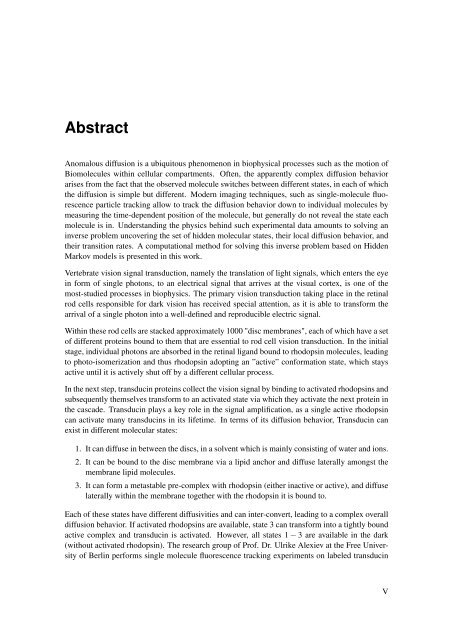Diffusion Processes with Hidden States from ... - FU Berlin, FB MI
Diffusion Processes with Hidden States from ... - FU Berlin, FB MI
Diffusion Processes with Hidden States from ... - FU Berlin, FB MI
Create successful ePaper yourself
Turn your PDF publications into a flip-book with our unique Google optimized e-Paper software.
AbstractAnomalous diffusion is a ubiquitous phenomenon in biophysical processes such as the motion ofBiomolecules <strong>with</strong>in cellular compartments. Often, the apparently complex diffusion behaviorarises <strong>from</strong> the fact that the observed molecule switches between different states, in each of whichthe diffusion is simple but different. Modern imaging techniques, such as single-molecule fluorescenceparticle tracking allow to track the diffusion behavior down to individual molecules bymeasuring the time-dependent position of the molecule, but generally do not reveal the state eachmolecule is in. Understanding the physics behind such experimental data amounts to solving aninverse problem uncovering the set of hidden molecular states, their local diffusion behavior, andtheir transition rates. A computational method for solving this inverse problem based on <strong>Hidden</strong>Markov models is presented in this work.Vertebrate vision signal transduction, namely the translation of light signals, which enters the eyein form of single photons, to an electrical signal that arrives at the visual cortex, is one of themost-studied processes in biophysics. The primary vision transduction taking place in the retinalrod cells responsible for dark vision has received special attention, as it is able to transform thearrival of a single photon into a well-defined and reproducible electric signal.Within these rod cells are stacked approximately 1000 "disc membranes", each of which have a setof different proteins bound to them that are essential to rod cell vision transduction. In the initialstage, individual photons are absorbed in the retinal ligand bound to rhodopsin molecules, leadingto photo-isomerization and thus rhodopsin adopting an ”active” conformation state, which staysactive until it is actively shut off by a different cellular process.In the next step, transducin proteins collect the vision signal by binding to activated rhodopsins andsubsequently themselves transform to an activated state via which they activate the next protein inthe cascade. Transducin plays a key role in the signal amplification, as a single active rhodopsincan activate many transducins in its lifetime. In terms of its diffusion behavior, Transducin canexist in different molecular states:1. It can diffuse in between the discs, in a solvent which is mainly consisting of water and ions.2. It can be bound to the disc membrane via a lipid anchor and diffuse laterally amongst themembrane lipid molecules.3. It can form a metastable pre-complex <strong>with</strong> rhodopsin (either inactive or active), and diffuselaterally <strong>with</strong>in the membrane together <strong>with</strong> the rhodopsin it is bound to.Each of these states have different diffusivities and can inter-convert, leading to a complex overalldiffusion behavior. If activated rhodopsins are available, state 3 can transform into a tightly boundactive complex and transducin is activated. However, all states 1 − 3 are available in the dark(<strong>with</strong>out activated rhodopsin). The research group of Prof. Dr. Ulrike Alexiev at the Free Universityof <strong>Berlin</strong> performs single molecule fluorescence tracking experiments on labeled transducinV









